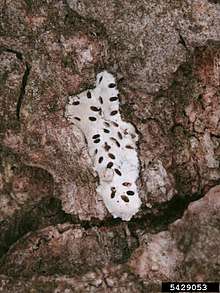Archips crataegana
Archips crataegana, the brown oak tortrix, is a moth of the family Tortricidae. It is found in most of Europe[2] east to Japan.

Eggs
| Archips crataegana | |
|---|---|
 | |
| Scientific classification | |
| Kingdom: | Animalia |
| Phylum: | Arthropoda |
| Class: | Insecta |
| Order: | Lepidoptera |
| Family: | Tortricidae |
| Genus: | Archips |
| Species: | A. crataegana |
| Binomial name | |
| Archips crataegana | |
| Synonyms | |
| |
The wingspan is about 20 mm for males and about 25 mm for females. Adults are sexually dimorphic. They are on wing from June to August.[3]
The larvae feed on various deciduous trees, including Quercus, Ulmus, Fraxinus and Salix species. They feed in a tightly-rolled leaf. The species overwinters as an egg.[4]
Subspecies
- Archips crataeganus crataeganus
- Archips crataeganus endoi Yasuda, 1975 (South Korea, Japan, China: Heilongjiang, Jilin, Shaanxi, Sichuan)
gollark: ... FIREFOX.
gollark: Install it.
gollark: Firefox.
gollark: Switch to a different browser. Help reduce Google's monopolization of the interwebs.
gollark: when you should just not use chrome
References
This article is issued from Wikipedia. The text is licensed under Creative Commons - Attribution - Sharealike. Additional terms may apply for the media files.